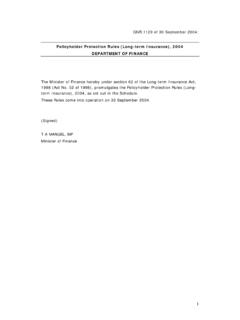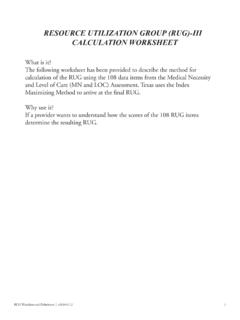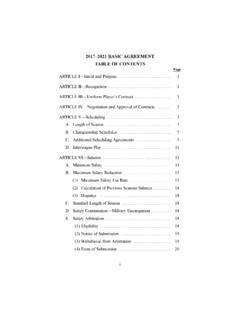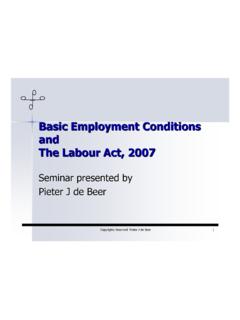Transcription of Step by Step Guide - SKC Ltd
1 By step GuideAn Introduction to Air SamplingAir Sampling BasicsPage 2 224-G1 Issue E is air sampling? ..1 Sampling Methods ..2 Types of Contaminant ..3 Basic Formulae ..4 Definitions ..5 The Dust Diagram ..6 Dust Conventions ..7mg/m and ppm ..8 Calibration ..9 Dust Sampling - Inhalable ..10 Dust Sampling - Inhalable & Respirable ..11 Dust Sampling - Respirable ..12 Gas & Vapour Sampling ..13 The Sample Train ..15 Questions for a Sampling Protocol ..16A helping hand from the expertsThis Guide is designed as an introduction to the basic principles of air sampling methods. The advice in this Guide deals with the setting up of equipment notes relating to specific sampling methods can be obtained from the HSE ( ) and these will give you a good understanding of the approach you should take to sampling in your particular an expert in the field of air sampling, SKC believe in supporting customers every step of the way, so in addition to the step By step guides there is a range of training seminars available to help you get the best from your sampling equipment.
2 If you are new to air sampling, our one day seminar 'A Practical Course in Air Monitoring' will give you the help you need to get started. The course includes both theoretical and practical sessions in the use of air sampling equipment. An experienced practitioner will offer valuable input on sampling strategy and will assist with instrument configuration and calibration. You will soon have everything you need to formulate a professional monitoring programme. Contact SKC Limited customer services today for details on courses and available dates:T: +44 (0) 1258 480188 E: 224-G1 Issue E Page 1 What is air sampling?What is air sampling?Put simply, air sampling is capturing the contaminant from a known volume of air, measuring the amount of contaminant captured, and expressing it as a air is passed through a filter medium (normally a paper for solid contaminants and a sorbent for gases).
3 The volume of air is measured against the amount of contaminant captured. This gives the concentration, which is expressed either as milligrams per cubic metre (mg/m3) or parts per million (ppm).The volume of air is calculated by multiplying the flow rate through the filter medium by the time in minutes. Calibration of the flow rate is important and should be carried out before and after each sample is is it done?There are many different methods of taking air samples, but by far the most widely used and preferred is to connect a battery operated pump to a filter medium. The pump should be capable of drawing air through the filter at a constant rate for a time in excess of 8 hours, even in adverse conditions such as extreme criteria is based around the recommendations that samples should be taken on a personal basis for an 8 hour Time Weighted Average (TWA).
4 Other types of sampling, notably the Short Term Exposure Limit (STEL) present no problems for the pump is also worth remembering that a sample by definition is a very small part of the whole. For example: taking one or two parts from a batch of one hundred and checking them does not necessarily mean that the other ninety eight parts will be the same. Do not assume that a result from your air sample is exactly what is in the atmosphere all the 2 224-G1 Issue E MethodsFilter Sampling Inhalable (Total) DustAir is drawn through a filter paper, which traps the solid particulate dust, aerosols & fibres. Gravimetric analysis is usually used to measure results ( by measuring the weight gain of the filter). Further analysis can be carried out on the filter to identify the specific chemicals Respirable DustThe * Sampler with a foam plug placed in the cassette inlet is capable of sampling respirable dust.
5 The specific foam separates the respirable fraction, which is collected on the filter, from other particle Sampling Respirable (Alternative Method)The Cyclone Sampler uses a filter contained in a cassette, which separates out the respirable fraction of dust in the SamplingSorbents are normally contained in a small glass tube with sealed ends. Air is drawn through the sorbent, which captures molecules of the gas or vapour to be sampled. The trapped contaminants are released using solvent washing or heat to a gas chromatograph (GC) for analysis. One of the best known sorbents is SamplingParticularly suitable for ''grab'' or Short Term Samples (STS), the air is passed through the pump into a special plastic bag.
6 Alternative methods of filling a bag without passing air through a pump can also be used. The bag, containing a relatively large volume of sampled atmosphere is then taken to the laboratory for SamplingAir drawn into the impinger is forced through a nozzle, which is covered by a liquid such as high purity water. The pollutant dissolves in the liquid and is subsequently analysed, usually by colorimetric MethodsThere are alternative samplers to those shown above, including combinations of tube & filter, impinger and special samplers for specific uses such as chemically impregnated filters and passive badges. Details of all of these methods can be found in the SKC catalogue. To order your copy contact our customer services team on +44 (0) 1258 480188.
7 *Manufactured under license from the Institute of Occupational Medicine TM 224-G1 Issue E Page 3 Types of ContaminantThere are three types of contaminant according to their physical properties: Particulates Vapours GasesParticulates can be further subdivided into five types: Aerosols Dusts Fumes Smokes MistsContaminant DefinitionsAerosolDispersion in air of solid particles of microscopic particulate capable of temporary suspension in air. Dusts are usually derived from larger masses through the application of physical particles produced by condensation from the gaseous phase. Fumes are usually derived from the heating of a solid to its melting point and the subsequent cooling of the gas resulting from the incomplete combustion of organic matter consisting predominantly of carbon and oxides of in air of liquid droplets usually large enough to be seen by the naked phase of a substance that usually exists as a liquid or solid at normal room temperature and substance which does not normally exist as a liquid or solid at normal room temperature and 4 224-G1 Issue E FormulaeCalculation of the volume of air sampled:Volume of air sampled = Sample flow rate x sample timeExample.
8 Flow rate = 2 l/min Sample time = 8 hours = 8 x 60 = 480 minutes Volume of air = 2 (l/min) x 480 (minutes) = 960 litres Volume of air = 960 / 1000 = m (cubic metres)Conversion of ppm (parts per million) to mg (milligrams):mg/m = ppm x (molecular weight* / 24)*If the molecular weight of the contaminant is not known it can be determined using a periodic of time weighted average (TWA):To determine an 8 hour TWA from more than one sample within any 24 hour period:TWA = (C1 x T1) + (C2 x T2) + ..(Cn x Tn) 8where C is the occupational exposure and T is the time for that : An operator is exposed to for 7 hours and 20 minutes. The 8 hour TWA is therefore 7h20min @ (C1 x T1) plus 40min at 0mg/m (C2 x T2). TWA = ( x ) + (0 x ) = 8 Note: 7h20min = hours, 40min = 224-G1 Issue E Page 5 DefinitionsExposure Limit DefinitionsMaximum Exposure Limit (MEL)An MEL is the maximum concentration of airborne substance to which employees may be exposed by inhalation averaged over a regulatory required reference period and must not be Exposure Limit (OEL)As defined by the Occupational Exposure Standards (OES), an OEL is the concentration of an airborne substance, averaged over a reference period at which, according to current knowledge, there is no evidence that it is likely to be injurious to employees if they are exposed by inhalation day after day to that concentration.
9 These were replaced on 6th April 2005 by WELs (refer to EH40/2005).Workplace Exposure Limit (WEL)WELs are concentrations of hazardous substances in the air, averaged over a specified period of time referred to as a time weighted average (TWA). Two time periods are used: Long term (8 hours) and short term (15 minutes). Short term exposure limits (STELs) are set to help prevent effects, such as eye irritation, which may occur following exposure for a few 6 224-G1 Issue E Dust DiagramAIR SAMPLE1. Amount collected2. Flow of air through filter3. Time runFlow x Time = Volume through filter in litres or cubic metresVolume and Amount gives CONCENTRATION in mg/m orparts per million (ppm)An air sample requires three basic meaurements: amount of pollutant collected, flow of air through the medium and the run time in exposure limits are based on personal exposure.
10 At this time there are NO limits for background or static samples, however, some people do take static samples for their own information to get an idea of general levels of contamination. If it is considered that a person creates their own airborne hazard as they work and that their face is normally in close proximity to that hazard, it is clear to see why personal sampling is the accepted way of measuring SamplingAll exposure limits are based on a personal 224-G1 Issue E Page 7 Dust ConventionsDust, or more correctly aerosol, is split into three size ranges, which have different effects on the respiratory system of a human being, as detailed in the diagram to the right. The smaller the particle the deeper into the lungs it can penetrate where it can settle onto the lining and cause respiratory illness, for example, a well known problem caused by respirable dust is Silicosis in the coal mining respirable dust has demanded the most attention but in the last few years particles of larger sizes have been investigated for their effect on the upper respiratory tract (throat, nose and mouth).








